Crotalus catalinensis facts for kids
Quick facts for kids Crotalus catalinensis |
|
|---|---|
 |
|
| Conservation status | |
| Scientific classification | |
| Genus: |
Crotalus
|
| Species: |
catalinensis
|
 |
|
The Santa Catalina rattlesnake (Crotalus catalinensis) is a special kind of snake found only on Isla Santa Catalina. This island is in the Gulf of California, near Baja California Sur, Mexico.
Like other pit vipers, this snake is venomous, meaning it uses venom to catch its food. But what makes it really unique is that it doesn't have a rattle! Most rattlesnakes shake their tail to make a warning sound, but the Santa Catalina rattlesnake cannot.
This snake is usually active at night. It is also considered Critically Endangered, which means it's at a very high risk of disappearing forever.
Contents
What Does It Look Like?
This snake is quite thin and not very long. It usually grows to about 73 centimeters (2.4 feet) in length.
No Rattle!
The most amazing thing about the Santa Catalina rattlesnake is that it doesn't have a rattle. When other rattlesnakes shed their skin, their rattle grows a new part. But for this snake, the rattle part of its tail is so small that it just falls off every time it sheds.
Scientists think this happened because the snake didn't need a rattle on its island home. There aren't many big animals that would step on it or predators that it needs to warn away. So, the rattle became useless and eventually disappeared.
Other rattlesnakes on islands in the Gulf of California also seem to be losing their rattles. This shows how animals can change over time to fit their environment.
Body Shape and Colors
This snake has a longer body and longer teeth than its relatives on the mainland. These features help it hunt in trees and bushes. Unlike other rattlesnakes that bite and then let go, the Santa Catalina rattlesnake holds onto its prey until the venom works. This stops its food from falling or flying away.
Santa Catalina rattlesnakes come in two main colors. Most are light cream with reddish-brown spots on their back. They also have black and white bands near their tail. The other color is a lighter, ash-gray with darker gray spots.
Darker snakes can absorb more heat from the sun. This helps them digest food faster and become stronger, which can help them have more babies. However, being darker also means they are easier for predators to spot.
Where Does It Live?
This snake lives only on Isla Santa Catalina. This small island is about 43 square kilometers (17 square miles) in size. It's the only place in the world where you can find this specific snake.
Why Is It Endangered?
The Santa Catalina rattlesnake is listed as Critically Endangered. This means it faces a very high risk of extinction. Its home is very small, and its numbers are going down.
Main Dangers
- Collecting: Some people try to catch these rare snakes illegally.
- Cats: Wild cats were once a big problem on the island. They hunted the snakes and their food. Luckily, these cats were removed in 2002. But there's always a risk they could come back.
- Food Supply: The snake mainly eats a special mouse called Slevin's mouse (Peromyscus slevini). This mouse also lives only on the island. If the mouse population goes down, the snakes will suffer.
- Climate Change: Changes in temperature and rainfall can affect the plants and animals on the island, which impacts the snakes. Since snakes are ectotherms (cold-blooded), their body temperature depends on the outside temperature.
- Small Island Problems: Because the island is so small, the snakes might face problems like inbreeding (when closely related animals have babies). This can make them less healthy.
There are not many active efforts to protect this snake right now. Protecting the island's habitat and the mouse population would greatly help the Santa Catalina rattlesnake survive.
What Is Its Home Like?
The Santa Catalina Island has desert plants along its coast. These snakes are often found on the western side of the island in dry riverbeds called arroyos. They also live in plains, ravines, and rocky hills. They often hide in rock cracks or thick plants. Hiding in plants helps them stay at a good body temperature and hide from predators.
How Does It Behave?
Most rattlesnakes are heavy and stay on the ground. But the Santa Catalina rattlesnake is small and can climb very well.
Scientists once thought they climbed trees to hunt birds. However, studies show they mostly eat mammals, just like other rattlesnakes. They do climb into bushes, especially in July, the hottest month. They do this to cool down, getting off the hot ground.
Unlike many rattlesnakes that hide, the Santa Catalina rattlesnake is often seen out in the open. This supports the idea that it doesn't need to hide or warn predators because it doesn't have many on the island.
Even though it was once thought they were active day and night, more recent studies show they are mostly active at night, even in winter. They do not hibernate.
What Does It Eat?
Studies from 2002 to 2004 showed that the Santa Catalina rattlesnake's diet is mostly made up of mammals (70%) and lizards (30%). Their main food is the Slevin's mouse (Peromyscus slevini). They also eat lizards like the Santa Catalina desert iguana and side-blotched lizard.
They do not seem to eat birds, even though they can climb. Their diet is much more limited than their closest relative, the Red diamond rattlesnake, which eats many different animals. This is because there isn't as much variety of prey on the island. The Santa Catalina rattlesnake's smaller size might be a way it has adapted to eating smaller prey like the Slevin's mouse.
Like other rattlesnakes in Mexico, the Santa Catalina rattlesnake hunts more during the summer and rainy season, from July to October.
Images for kids
See also
 In Spanish: Serpiente de cascabel de Santa Catalina para niños
In Spanish: Serpiente de cascabel de Santa Catalina para niños





